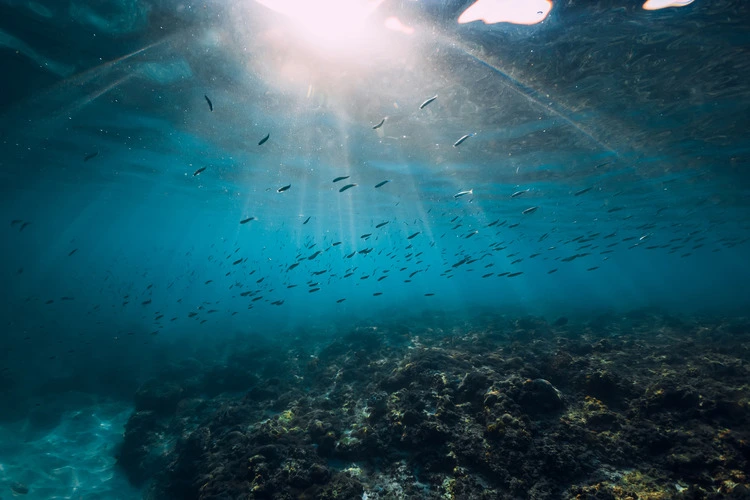
2024 led scientists to a multitude of ocean discoveries: a sparkling sea worm, an underwater mountain and the deepest ship-wreck ever found
By
Five per cent. That’s the minute amount of the ocean that humans have explored so far, and less than ten per cent has been mapped using modern sonar technology.
It’s well-known that humans have found out more about outer space than we have of the watery depths of our world. Clearly, we have an almost unfathomable amount of information left to learn about what lies under the ocean’s surface.
But each year, our planet’s largest living space – covering more than 70 per cent of the Earth – continues to reveal its secrets as technology becomes more advanced. Read on to uncover some of the most interesting discoveries found in oceans in 2024 alone:
1) A new crustacean species in the Atacama Trench
Named after the word ‘darkness’ in the languages of the peoples from the Andes region, the Dulcibella camanchaca is an amphipod just 4 centimetres in length but a mighty predator in its own right. It possesses ‘raptorial appendages’, which it uses to capture smaller prey in its ecosystem.
The amphipod was found in the Atacama Trench – within the deepest 45 per cent of the ocean – which stretches along the eastern South Pacific Ocean and reaches depths of more than 5 miles (8km).
2) An underwater mountain
In September this year, a seamount – almost four times as high as the Burj Khalifa – was discovered in watery depths around 900 miles (1,450km) off Chile’s coast. The newly-discovered underwater mountain boasts a plethora of new species from Casper octopus, comically-named ‘flying spaghetti monsters’ and fish that looks like a Muppet.
Scientists found the seamount after a 28-day expedition exploring underwater mountain ranges like the Nazca Ridge and Salas y Gómez Ridge, in areas never studied before.
Enjoying these 2024 ocean discoveries? Check out our related reads:
3) A glowing sea slug
Normally, sea slugs inhabit coral reefs, tide pools and shallow seabeds, but scientists made a surprising discovery in 2024 when a glowing sea slug was found in the midnight zone of the ocean (where no sunlight reaches).
Around the same size as a baseball, the sea slug was first spotted around 25 years ago, but until now has evaded scientists who thought it might be a type of mollusc. In a recent study, scientists captured 18 of them to look at their anatomy, finding the sea slug was so distantly related to known species that it belonged to a new family.
Named Bathydevius caudactylus, some of its adaptations include a forked tail which glows – and then detaches – when threatened, as well as a floppy ‘hood’ that it uses to move by shooting jets of water out of it.
4) More than 100 species off Chile’s coast
A huge swathe of species were found earlier this year living on seamounts off the coast of Chile. The vast array of discoveries by scientists included spiralling corals, squat lobsters, amphipods and sea urchins, all of which are likely new to science.
Researchers believe that it may take years to fully identify all of the species.
5) Dark oxygen
A fascinating discovery of how oxygen is produced was made in 2024.
New research conducted in the Pacific Ocean has revealed oxygen production occurs in complete darkness at the seafloor by metallic ‘nodules’, almost 2.5 miles (4km) below the ocean surface where no light can reach.
Scientists theorise that this oxygen is likely to support a plethora of life underwater, but deep-sea mining companies are already eyeing up the nodules since they contain valuable metals like lithium and copper, used in battery production.
6) A ‘sassy sparkler’ sea worm
While exploring the Chile Margin – which runs the entire length of South America – researchers were quite literally dazzled to find the shimmery, iridescent ‘sassy sparkler’ sea worm using its robotic explorer ROV SuBastian. On first appearance, the polychaete – a type of deep-sea worm – has bristles that might seem rather ordinary, but as it moves they sparkle and reflect light to produce a pink sheen.
As the researchers say, ‘to describe this polychaete, one simply must use jazz hands!’
7) The USSR Harder submarine wreck
Almost eight decades after it was last in service, the USS Harder wreck was discovered mostly intact – and upright – on the seafloor in the South China Sea near Luzon in May 2024.
The submarine was known for sinking the most Japanese warships in World War Two, and was last seen after a battle with a Japanese ship before disappearing off the coast of the Philippines with 79 crew onboard.
8) Animals living underneath the sea floor
For the first time, scientists discovered species that could survive within the intense conditions of cavities almost 1.6 miles (2.5km) beneath the sea floor. Below hydrothermal vents releasing vast quantities of hot water, researchers found giant tubeworms (Riftia pachyptila), snails as well as other worm species. Until this study – published in October 2024 – scientists thought that only microbes could live underneath the sea floor.
Living in such harsh conditions has meant the animals possess rather unique adaptations: in the case of the giant tubeworm, the list is extensive: it roots itself in one place as an adult and has no stomach or digestive system.
Bizarrely, the species also requires an infection from bacteria to produce energy. A symbiotic relationship ensues: the worm provides bacteria with chemical energy – to ensure its survival – while the bacteria provides food for the tubeworm.




